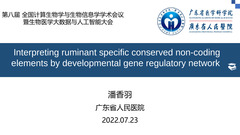Interpreting ruminant specific conserved non-coding elements by developmental gene regulatory network
编号:45
稿件编号:1 访问权限:仅限参会人
更新:2022-07-22 22:10:53
浏览:973次
口头报告

报告开始:2022年07月23日 17:10 (Asia/Shanghai)
报告时间:15min
所在会议:[S3] 分会场3 » [S3-1] 系统生物学与分子进化
摘要
To answer the central question that how do new traits arise during macro-evolutionary process, biologist have long realized that we need to understand the gene regulation in development, i.e., to understand which genes, what kinds of DNA sequence changes in their regulatory elements, what the effect of those genes in development are responsible for morphological diversity (Carroll, 2008). Until recently large-scale data accumulation allows us to explore this theoretical concept. In this manuscript, we took the ruminant multi-chambered stomach, a notable organ innovation as the cornerstones of evolutionary theory, as an example to illustrate a novel strategy to tackle the fundamental question. Our main idea is to computationally interpret conserved non-coding elements in developmental regulatory network by integrating newly generated multi-omics data in development with our previous comparative genomes (to study rumen origin in Chen et al., 2019) and comparative transcriptomics (to study rumen's functional innovations in Pan et al., 2021).
Specifically, we sequenced 37 ATAC-seq and 34 RNA-seq of ruminal epithelial cell, esophageal epithelial cell, and hepatocyte cell at five time points from 14 sheep and depicted the landscape of accessible chromatin and gene expression during rumen development. Then we developed a framework, Conserved Non-coding Element interpretation method by gene Regulatory network (CNEReg) to define toolkit transcription factors (TTFs) and model its regulation on rumen specific gene activation via batteries of ruminant-specific conserved non-coding elements (RSCNEs) during development (Figure 1 and Table 1). The resulting genome-wide developmental gene regulatory network reveals that 18 TTFs and 313 active-RSCNEs cooperatively regulate rumen’s multiple functional modules. Importantly, we identified OTX1, SOX21, HOXC8, SOX2, TP63, PPARG utilize 16 active-RSCNEs to alter developmental regulation to diverge rumen from esophagus.
Overall, we implemented the evo-devo thinking that gene regulation could evolve and shape animal evolution and demonstrated a systematic approach to understand the large-scale maps of conserved noncoding elements by modeling developmental multi-omics data. Our study paved the way to the computational discover the developmental genetic toolkit TFs which may controls development, pattern formulation, and identity of body parts. This is usually only can be done by mutagenesis screen on animal models easy to breed in laboratory and with rapid development and abundant offspring. Importantly, we provide a novel method for systematically interpreting conserved cis-regulatory sequence in non-coding region will have broad interest in other complex trait studies.
Specifically, we sequenced 37 ATAC-seq and 34 RNA-seq of ruminal epithelial cell, esophageal epithelial cell, and hepatocyte cell at five time points from 14 sheep and depicted the landscape of accessible chromatin and gene expression during rumen development. Then we developed a framework, Conserved Non-coding Element interpretation method by gene Regulatory network (CNEReg) to define toolkit transcription factors (TTFs) and model its regulation on rumen specific gene activation via batteries of ruminant-specific conserved non-coding elements (RSCNEs) during development (Figure 1 and Table 1). The resulting genome-wide developmental gene regulatory network reveals that 18 TTFs and 313 active-RSCNEs cooperatively regulate rumen’s multiple functional modules. Importantly, we identified OTX1, SOX21, HOXC8, SOX2, TP63, PPARG utilize 16 active-RSCNEs to alter developmental regulation to diverge rumen from esophagus.
Overall, we implemented the evo-devo thinking that gene regulation could evolve and shape animal evolution and demonstrated a systematic approach to understand the large-scale maps of conserved noncoding elements by modeling developmental multi-omics data. Our study paved the way to the computational discover the developmental genetic toolkit TFs which may controls development, pattern formulation, and identity of body parts. This is usually only can be done by mutagenesis screen on animal models easy to breed in laboratory and with rapid development and abundant offspring. Importantly, we provide a novel method for systematically interpreting conserved cis-regulatory sequence in non-coding region will have broad interest in other complex trait studies.
关键字
Trait innovation,Gene regulatory network,Conserved non-coding element,Toolkit transcription factors,Ruminant
报告人

潘香羽
西北农林科技大学;广东省人民医院广东省人民医院,广东省医学科学院,在站博士后
发表评论